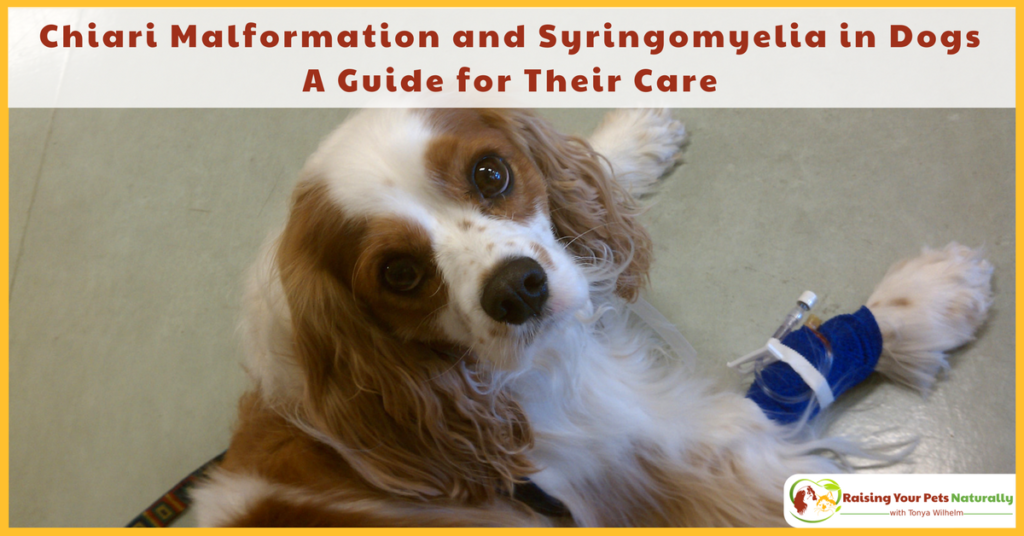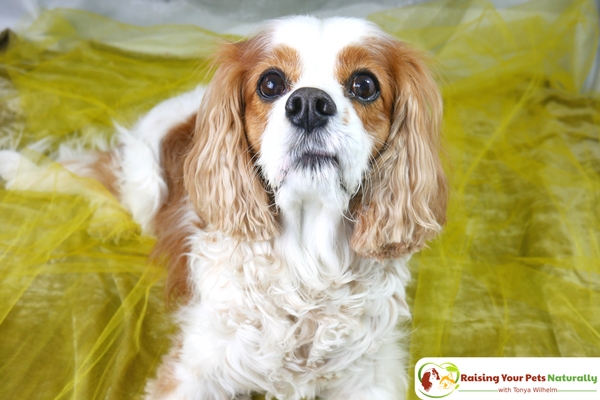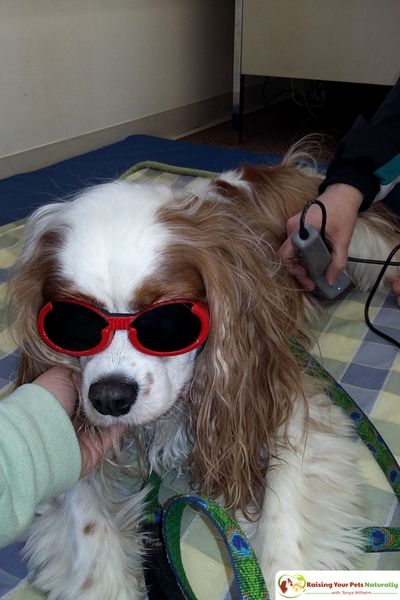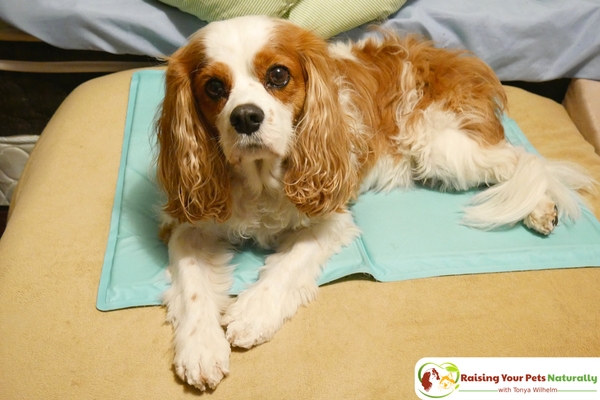Google Adsense—>

Chiari Malformation and Syringomyelia in Dogs and the Cavalier King Charles Spaniel
A Practical Guide for Living and Treatment for CM and SM in Dogs

My best friend, Dexter The Dog, was diagnosed with Chiari Malformation and Syringomyelia in 2012, just before his third birthday. His diagnosis was a big blow to my heart. Over the last 6 years, I’ve written a lot on Dexter’s diagnosis, his care and treatments.
I’ve been asked by my Cavalier community to make a bit of a list for easy reference. I hope you find this article on Chiari malformation and syringomyelia in dogs helpful. My request is that you share this information so that others dealing with this heartbreaking diagnosis can also learn that there are many helpful and natural treatments for dogs with Chiari malformation and syringomyelia.
What is Chiari Malformation (CM)?
Chiari malformation (CM) is when the skull is too small to hold the brain. Because of the brain growth in such a small cavity, the cerebellum and medulla are pushed out and obstruct the normal flow of cerebrospinal fluid.
What is Syringomyelia (SM)?
Because of the obstruction of normal cerebrospinal fluid, there is a buildup of pressure. This pressure can be compared to holding your finger over half of the opening of a lawn hose, preventing the water from flowing freely. That pressure then can cause fluid-filled cavities within the spinal cord known as syringomyelia (SM).
What are Chiari Malformation and Syringomyelia Symptoms in Dogs?
Symptoms of CM and SM in cavaliers and other breeds vary. In fact, they vary a LOT! About a year prior to Dexter’s diagnosis, he started to do a few odd behaviors. First, he seemed to gaze out and get focused on dust particles floating in the sun. Second, he would get focused on his rear end and start fidgeting and biting at his bottom. I took him in to his veterinarian; they checked his anal glands. His diagnosis was that they were slightly full, and maybe he was just more sensitive to when they emptied. Third, he would get really weird after a random fly, gnat, or another flying insect would pass by him or happened to land on him. He would, spin around, growl, and become very “strange.” The fourth symptom, the one that put us over the top, was when he started to growl at his back end and almost get into a trance.
I talked to a Cavalier friend and vet, Dr. Lynette Cole at The Ohio State University. She advised me to record the next episode. I did, and three veterinarian neurologists suspected Chiari malformation and syringomyelia.
Dexter’s CM/SM Video
This is how Dexter presented with his disease. However, other common symptoms of CM/SM can include one or more of the below.
- Air scratching, particularly on walks or when excited.
- Head scratching or rubbing.
- Air snapping or licking.
- Random yelps out in pain.
- Sensitive to touch and being picked up.
- Hind end weakness.
- Head or body wobbles, bobbles, stumbling, eye flickers, or squinting.
- Head pressing.
- Seeking darkness or wanting to be left alone.
- Inactivity or depression.
- Restlessness.
Diagnosing Chiari Malformation and Syringomyelia
The only way to truly diagnose this disease is an MRI. If a dog is presenting some of the common symptoms of CM/SM and is a breed prone to this disease (Cavalier King Charles Spaniels, Chihuahua Brussels Griffons, Yorkshire Terriers, Maltese, and other small toy breeds), a vet may start treatment without an MRI confirmation.
For me, I’m a person who always wants to know all that I can and treat accordingly. If I’d just started to treat Dexter for CM/SM without really knowing, I would always be doubting myself and worried that I may be missing another disease. Because Dexter was so focused on his lower lumbar area, the neurologists also performed a spinal tap to ensure we had all the facts.

Chiari Malformation and Syringomyelia Treatment Options
Chiari Malformation and Syringomyelia Surgery
There is a surgical option aimed at restoring the normal flow of spinal fluid. This usually involves decompression, removing pieces of bone, and adding a shunt. The results are varied, with most dogs still feeling pain and needing medications.
Pharmaceuticals to Treat Chiari Malformation and Syringomyelia
The disease is progressive and varies in severity from dog to dog. There is no cure, only various treatments to aid in comfort and lessen pain. Just like the wide variety of symptoms a dog may exhibit for CM/SM, treatment options are just as varied. Pharmaceuticals are likely going to play a role in treating your dog’s symptoms. Dr. Clare Rusbridge, has been the leading specialist in treating dogs with this disease. She offers a wealth of information on her website, along with a pharmaceutical treatment protocol.
When you find that your dog needs to be on regular pharmaceuticals, it is important to play a proactive role in evaluating his organ functions and supporting his organs. Read this article for more information.
Natural Treatment Options for Chiari Malformation and Syringomyelia
Luckily, there are a lot of other ways to help support a dog with CM/SM, to help him stay strong and as pain-free as possible. Here are some common natural treatments that you may consider for your dog. I will link to specific articles on how I’m using the treatment with Dexter when available.
Natural Treatment Samples. Don’t forget to subscribe!
Acupuncture to Treat Chiari Malformation and Syringomyelia
One of the first natural treatments Dexter received was acupuncture. We started our treatment once a week, then tapered off over the first year after his diagnosis. I spoke to Dexter’s acupuncturist, Dr. Mary Cardeccia and she explained the basic principles. Energy is continuity flowing through our bodies through specific pathways. When a pathway is disrupted or blocked, acupuncture helps restore the normal flow of energy. For dogs with CM/SM, their qi (energy) is stagnant along the spinal cord. Through the proper acupuncture points, this energy can be restored.
Dexter’s Acupuncture Treatment
Cold Laser Treatment
The other natural treatment I provided Dexter, was cold laser therapy. Cold laser therapy works by stimulating the cells, enabling them to heal themselves more efficiently. Cold laser treatments also help reduce inflammation, relieve pain, repair tissue damage, and increase blood circulation. This is still a treatment I use regularly for Dexter, and I also take Dexter to his vet for a treatment if he’s having a bad or painful day. It seems to help him feel better right after treatment. We now have added at-home laser treatment too!

Food Therapy
Shortly after Dexter’s diagnosis, I was introduced to the healing powers of food. I’ve been learning how I can use food for healing through a Traditional Chinese Veterinary Medicine (TCVM) perspective. There are foods and herbs such as sardines, shiitake mushrooms, celery, radishes, lemon, parsley, and marjoram that can help reduce fluid production. With less fluid production, Dexter has less spinal swelling and pain.
Chiari malformation and syringomyelia is a disease with inflammation. The other part of Dexter’s food therapy includes adding foods that reduce inflammation and avoiding foods that increase inflammation. Dexter is fed a species-appropriate diet of home-cooked or raw dog food. Processed, dry dog food is high in carbohydrates, which increases inflammation. Foods and supplements that I rotate into Dexter’s diet to help decrease inflammation can include blueberries, cruciferous vegetables (broccoli, cabbage), leafy greens, green-lipped mussels, CoQ10, bone broth, CBD oil, probiotics, and omega-3 fatty acids.
Conscious Proprioception, Awareness
One of the things I’ve noticed about Dexter is that he “shuffles” his feet when walking. During one of his veterinary exams, Dexter’s vet flipped his foot over so the top of his toes were touching the ground. By flipping a dog’s foot over, the vet is testing his conscious proprioception. In other words, the dog’s awareness that his foot is upside down. Most dogs will immediately flip their feet back to the normal position, Dexter did not fix his foot. Instead, he left it flipped upside down. He was not getting the signal to his brain that his foot was in the wrong position.
Dr. Cardeccia explains, “Because with the SM there is pressure on his spinal cord (from the pockets cerebrospinal fluid that form within the spinal cord near the brain), it is interfering with the nerves of proprioception, which are on the outer portion of the spinal cord. Proprioception is the internal sense that tells you where your body parts are without your having to look at them, so he is not actually fully aware of where his feet are, and that is why he drags them.”
Two treatments I’ve implemented for Dexter are the use of Dr. Buzby’s ToeGrips for Dogs and regular footwork exercises. Using the ToeGrips has brought Dexter an awareness about his feet through proprioceptive stimulus and help Dexter to pick up his feet. A week after wearing his first pair of ToeGrips, Dr. Cardeccia flipped his foot over, and he immediately flipped his foot back to position!
Dexter’s proprioception footwork includes things like walking over objects, walking on a variety of textures, walking sideways and back. This is all to help him be more aware of his feet.
Dog Core Strength Exercises
Next on Dexter’s dog rehabilitation agenda is to build up his core strength and back end strength. Strengthening Dexter’s core muscles and overall strength will help him with his balance issues. When he does lose his balance or starts to stumble, he will hopefully have the strength to catch himself. We do a variety of exercises on a variety of equipment to target Dexter’s abdominal, back, hind legs, etc.
Clip of Dexter’s Exercises
Canine Water or Hydrotherapy
Dog water therapy is a great way to help strengthen a dog’s body, while having a low impact on his joints. Because one of Dexter’s rehabilitation goals is to bring awareness to his hind feet, Dexter does regular water treadmill therapy. This provides not only strength and core strength, but also helps improve his proprioception. During the warm months, I also take Dexter to outdoor ponds and streams to allow him to walk in the water to continue with his therapy.
Dexter’s Water Therapy Session. Don’t forget to subscribe!
Exercise, Walking and Dog Play Limitations
This is a heartbreaker for me. Dexter has always been a spunky, playful, and active dog. Unfortunately, his disease has other things in mind. Each dog will be different on what they can and cannot tolerate. In the beginning, or as the disease progresses, these activities may change.
I’ve learned with Dexter, it’s about short spurts then rest. I also do a lot of training games and exercises, which include his at-home rehab work, that he finds fun and entertaining. This can take the place of rough or physical activities.
Possible Comforts
- Dog Harness. No Dog Collars, Please. One of the first things a newly diagnosed CM/SM dog parent should do is dump the dog collar and exchange it for a dog harness. Because the disease starts with a malformation of the skull, a dog collar can be quite painful. I’m never a fan of collars in the first place. Even finding a suitable dog harness can be a challenge. Each dog is different in where a pocket-filled cavity may be, so a harness that might work for one dog, may cause pain for another.
- Dog Strollers. Dog strollers are a great option for dogs with a neurological disorder, such as Chiari malformation and syringomyelia. This allows the dog to be comfortable and safe, while still being able to join in on the adventure. I always have Dexter’s stroller in my car, and I always bring it on long adventures. When he’s in need, I just pop him inside. Sometimes he rests up and then walks after his rest.
- Cooling Mats and/or Warming Blankets. I’m not sure why, but these dogs tend to run hot or cold. When Dexter was first diagnosed, and we were trying to find our groove, he always seemed cold. I made him a warming blanket, and he loved it! In a pinch, you can toss a fleece dog blanket in the dryer. It’s important to note that your dog should be able to remove himself if he feels too hot. Now, Dexter actually loves his cooling mat! He always gravitates to it, even in the winter. He doesn’t otherwise seem hot or uncomfortable in any way, but he will sleep more on it vs. a warm bed.
- Snuggle jackets or tight-fitting jackets, such as the ThunderShirt. This seems to be a 50/50 in the community. Some dogs immediately calm down from a painful episode, and others are in too much pain to wear clothing. Take your dog’s cue.
- Natural Calming Aids. I find this very helpful when Dexter seems to be having a rough day. I put in his favorite calming CD and will use a natural calming spray. I’m sure it has to do with the stress involved with the pain, and Dexter is not sure why he feels the way he does.

Support for Dogs with Chiari Malformation and Syringomyelia
Unfortunately, you are not alone. I say unfortunately because I wish this stupid diseases didn’t exist. It can be so heart-wrenching knowing our beloved dogs can suffer from such great pain. Quality of life issues always are at the forefront of our minds. My personal favorite support system came from a Facebook Group for dogs with CM/SM. This group is amazing, to say the least. They are so helpful, supportive, and very knowledgeable. Next, Dexter’s amazing team of specialists, and he has many. Finally, my family. They are my rock, so I can be Dexter’s rock.
I urge you to reach out to your veterinarians, specialists, and join the Facebook group if you think your dog may have Chiari malformation and syringomyelia. And, please share this article, so that others know of all the possible noninvasive treatments we can provide our beloved dogs with CM/SM and the support system in place.
Your questions or comments are welcome below.
Are you looking for even more ways to stay up to date with Raising Your Pets Naturally? Sign up for the newsletter for more tips and promotions. Don’t forget to be social and Like, Follow and Subscribe.
Facebook Twitter Pinterest Instagram YouTube
 |
 |

Google Adsense—>







This article is AMAIZING……….
I’ve learnt more from this than the “specialists”
Thank you! <3 Just trying to share all that we learn during our journey.
Thank you so much for this insightful information, I’m learning much more thru reading than any neurologist has been able to explain yet…. Alfie and Kathy Thomas
Thank you, Kathy & Alfie~! We have to keep reading, trying and learning for our pups. <3
Thank you, a very well done guide x
I’m glad you found it helpful.